
Blush savoy - 4 out of 5 slugs agree that this is one tasty cabbage.
I was recently asked a question. Actually it was more of a comment: "Broccoli, bah, never get the darn things to grow."
I chose to hear, "Dear Ottawa Gardener, please impart on me what you have learned by trial and error about how to make both heading and flowering brassicas do their thing with style, at least most of the time."
I know most of us bloggers/blog readers are strapped for time, so I'll make this a choose your own adventure.
1. Tell me about heading brassicas please
2. Go to technique for spring planted broccoli and cabbage.
3. I would like to learn about fall brassicas or how to not fail.
4. I've given up, just give me some good alternatives.
***
Tell me about heading brassicas please!
Let's define this as members of the Genus Brassica whose main eaten part are a tight heart of leaves that surround a flower bud - cabbage, nappa cabbage, and brussel sprouts - or the flower bud itself - broccoli, cauliflower, and rapini. Within this group are mostly annuals and biennials.* The biennials require exposure to prolonged cold temperatures before they will flower. Cabbage and brussel sprouts are in this category** and if they succesfully overwinter, will send up a flower stalk in the spring. We don't want this to happen prematurely as it would arrest the development of the yummy part - the tight whorl of wrapper leaves.
Vernalization - for you latin geeks out there is when a plant will not intiate flowering until undergoing a period of cold. Vernus = spring.
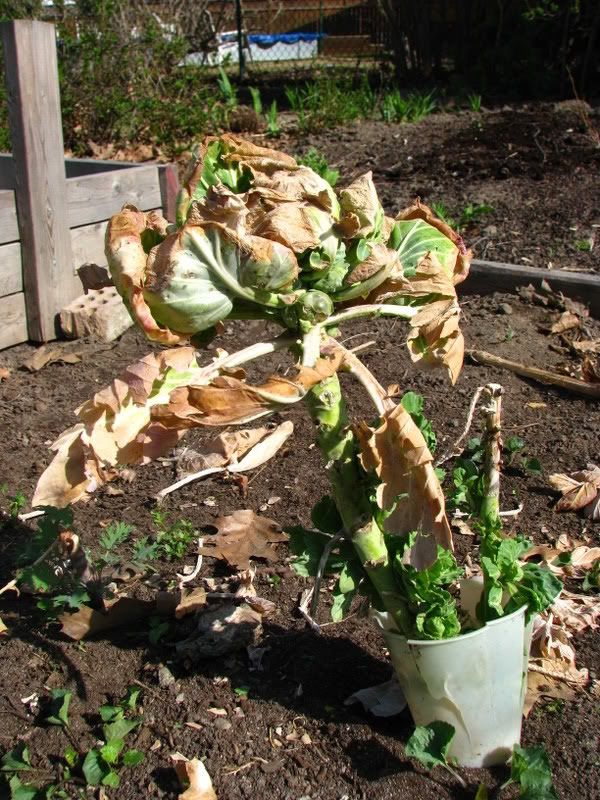
Brussel sprouts, often seen in pictures dusted with snow to demonstrate their haridness, survive the Ottawa winter somewhat intact and begin to go fluffy, preparing for flowering.
The edible flowerbud types can either be annuals such as most broccolis and cauliflowers marketed to cold climes or biennial like some kinds of Purple Sprouting Broccoli and Purple Cape Cauliflower.

Just to be different, here is a savoy that has re-headed with several smaller heads after the main head has been cut.
For those of us with harsh winter climates, we have a hard time getting our brassicas to overwinter intact so the fact that there are Brassicas out there that will provide a nice early crop of purple florets may be filed under 'trivia.'
Psst: Hardy kale will produce edible flowerbuds in the spring too, even in Ottawa.
Techniques for spring planted broccoli and cabbage.
I discovered this by accident after starting a crop too early and then experiencing a delayed spring. While you are reading this, keep in mind that people don't normally grow broccoli and cabbage this way as it can potentially expose them to sufficient cold to make them button - or flower prematurely with teeny weeny heads. I have yet to experience this.
1. Start your cabbage and broccoli indoors at the same time you start your tomatoes which will be about 6-8 weeks before last frost. Get them growing strong and quickly.
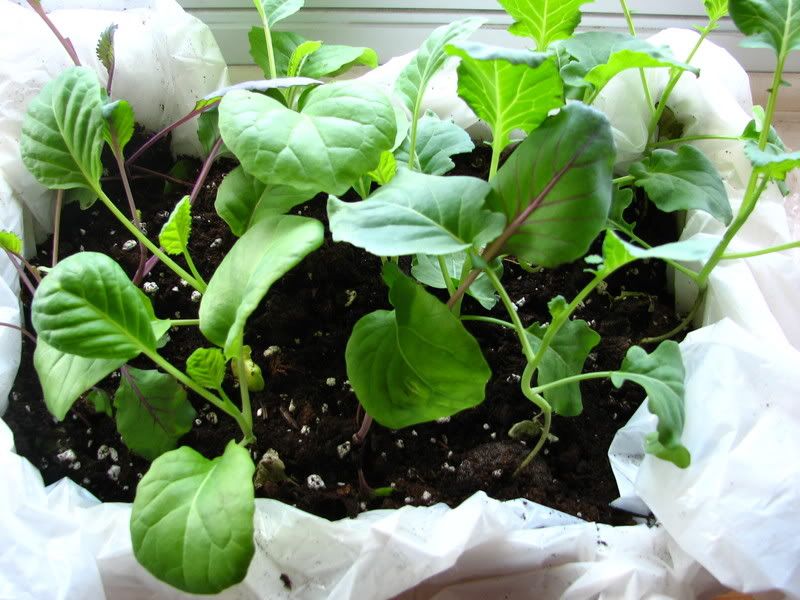
Here they are stuffed in a small clementine crate filled with a plastic bag and some starter soil. They are in a sunny south facing window.
2. Harden them off by letting them spend some time outside during the day in a coldframe or other protected location. Plant outside when when they are approximately 4 weeks old, under some sort of cloche or row cover. These recycled pop bottles (what do my neighbours think of my scrounging around in their recycling?) work very well. I have also 'double' wrapped by putting them under a glass cold frame in their little pop bottle cloches. Don't forget to take them off or prop them open if the day is sunny / warm.
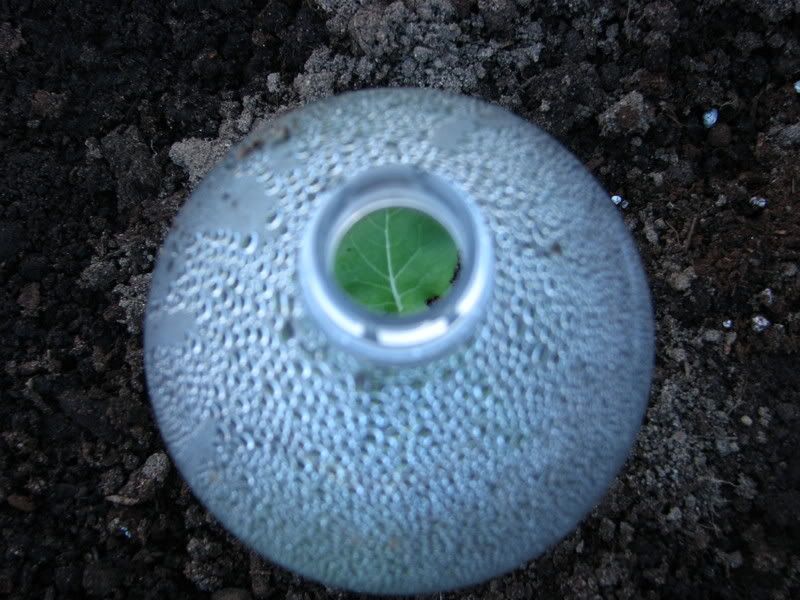
Notice the frost on the ground around this toasty little cloche?
3. You'll probably want to leave the cloche off entirely when nighttime temperatures are comfortably above freezing. This should give the cabbage and broccoli a good 6-8 weeks of cooler weather to develop into big plants.
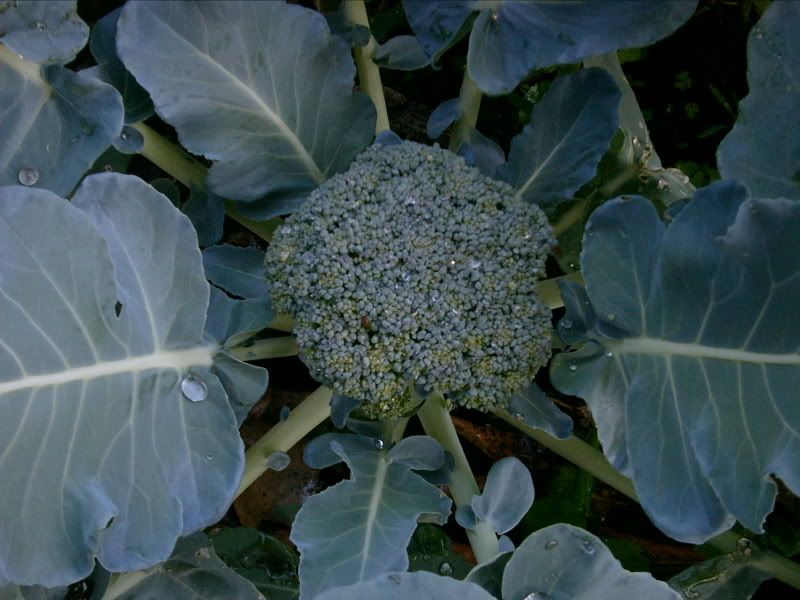
This is the same broccoli pictured in the cloche above in early summer.
Despite the fact that my baby plants have been experienced both frost and snowfall, this technique has given me the biggest broccoli and cabbage heads. I have also transplanted indoor started plants after last frost, and have direct seeded with less stellar results. I am not sure why they don't 'button' but it may have something to do with not experiencing enough cold, being transplanted at a non vulnerable stage of development or the varieties choosen which are cold resistant. Whatever the reason, this has worked well for me. This early broccoli also experiences very little pest damage.
I would like to learn about fall brassicas or how not to fail.
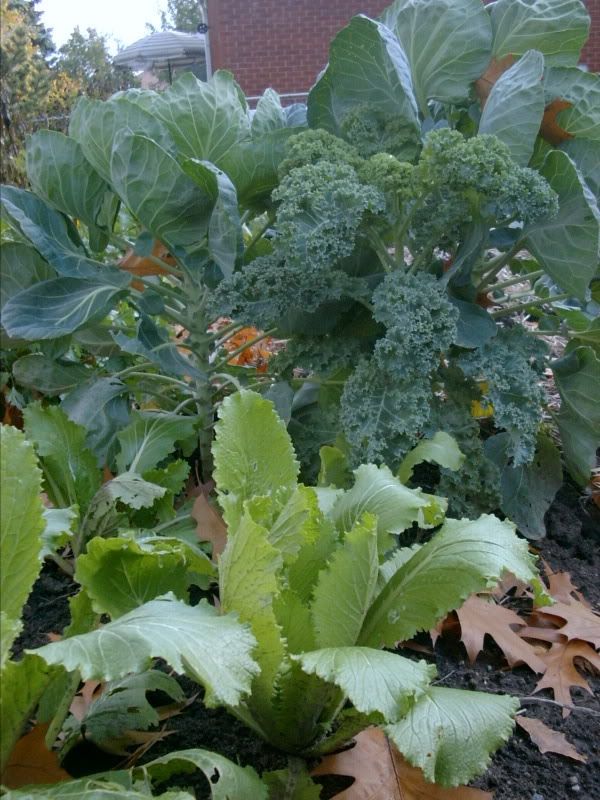
A fall bounty of brussel sprouts, kale and chinese 'lettuce' cabbage.
I may be overselling it but if you live in an area that is highly seasonal with a short spring or hot summers then you may want to try planting tricky cole crops so that they mature in the cool temperatures of fall. Brussel sprouts, nappa and other oriental cabbages, and cauliflower are most succesful planted this way. This will mean planting mid-summer, somewhere between 12-8 weeks before first frost depending on the plant. You can direct seed but just make sure to keep the ground well watered. To avoid excessive slug attacks and cutworm cursing, you may want to start them indoors. When they are around 4 weeks old, transplant to their permanent location. If this is in a coldframe then you can often extend the growing season beyond first snowfall.
I've given up, just give me some good alternatives.
You're right if you think that these are amoung the prima donas of vegetables. The bugs think they are delicious, they are prone to a range of diseases and they tend to be heavy feeders. If after all your care, you boil up a bunch of broccoli only to find your pot filled with floating green catepillars (happened to a friend of mine), you may despair (or feed the whole mess to your chickens). Thankfully there are some easy going alternatives, namely the leaf crops.
Kale is extremely hardy and will overwinter in Ottawa. Not only does it provide lots of nutritious and tasty leaves that can be used in most of the ways that you would prepare cabbage, it is also highly ornamental. In the spring, the plant will produce broccolini buds then spicy flowers followed by crunchy, young seepods and seeds that can be sprouted or saved.
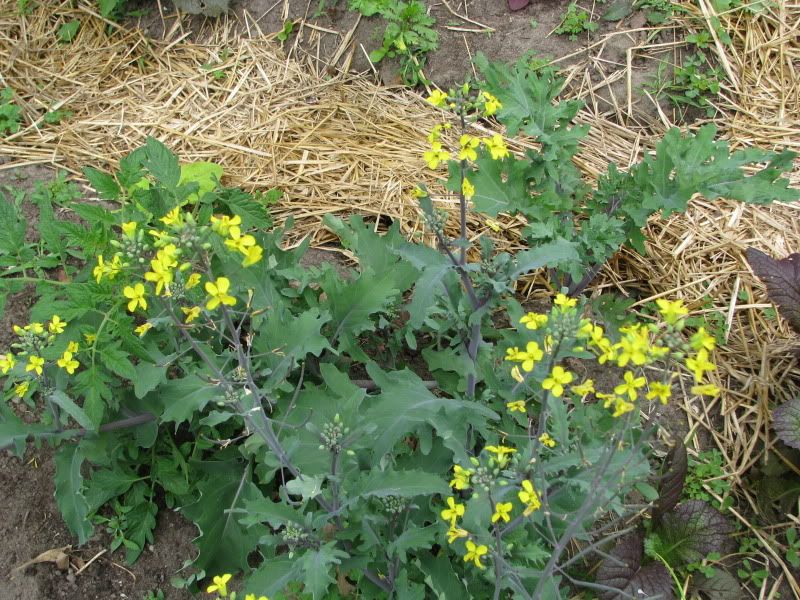
Red Ursa kale demonstrating four edible elements: flowers, seedpods, leaves and flowerbuds.
If you want to expand your brassica leaf horizons, try leaf broccoli, collards or couve tronchuda - the bok choy of B. oleracea, I have heard it called. I plan on trying that last one next year.
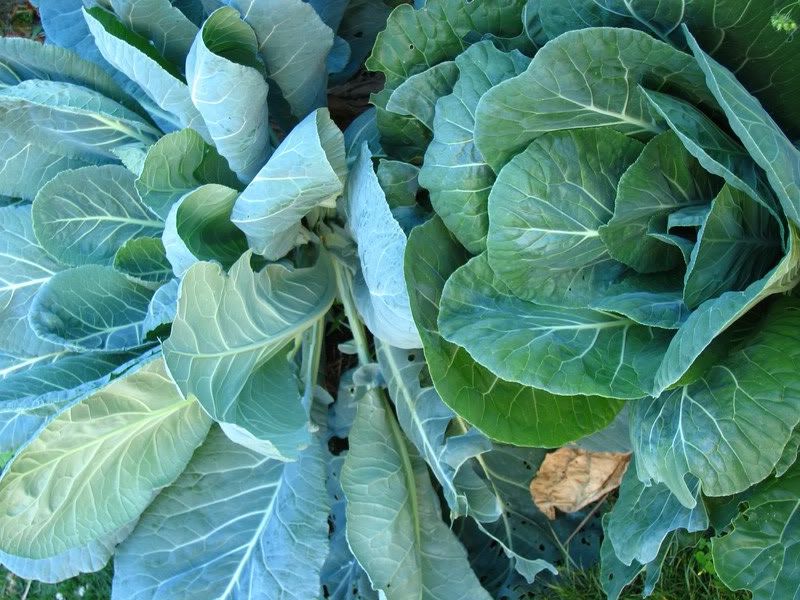
Collards - notice the variation in leaf colour and shape even though these came from the same packet.
Another tip: Brassicas generally prefer to grow in nuetral soil and may benefit from a bit of extra calcium which is why some people start them in eggshells though I find this impractical and a bit cramping for their root systems. They are said to grow best in mild climates with consistent water and fertility. I've noticed that the ones on the downslope of my raised bed get bigger.
***
* This 'footnote' has a picture

Nine star broccoli flowers in the second year to produce numerous white florets. As most of my gardening friends say, really it's more like cauliflower. It is considered a perennial in that if the plant is kept from going to seed, it will live for several years but it is more accurate to call it monocarpic meaning it will die after it has set seed.
Related post: Thoughts on overwintering brassicas
** Biennial brassics, especially those undergoing stress, can bolt to seed in the first year. I have had so called biennials live three or more years.
***
Did you notice that I somehow managed to not include a single red leafed Brassica in the whole post? You'll be reassured to know that almost all the above comes in fetching shades of maroon as well as green and silvery blue.

11 comments:
Good information. I know we share the earth with all God's creatures, but do the little green ones have to get my broccoli before I do? Haven't they heard about sharing? I'll likely start up the garden blog again next week.
I've found brassicas a lot easier to grow in the fall too. I still try them out every spring, but my fall crop is always better.
I might just give brussel sprouts another chance this year.
Mmmmmmmm, kale. Actually all the brassicas are my friends, but only in the fall.
Wow! Talk about a lot of information. My plan is to get the brassicas in early this year. Wish me luck.
I plan to grow a lot of cabbage and broccoli this year. I have always had a problem with the little green cabbage worms too. I have been told that bt (bacillus thuringiensis) will kill them, so I am going to use it on the brassicas this year.
Brussel sprouts can also be grown for shoots almost identical to sprouting broccoli. Leave the sprouts unpicked overwinter (or harvest the good ones and leave the poor ones). In early spring each sprout will 'blow' then produce a long edible shoot just like sprouting broccoli, but with slightly less flower head. A nitrogen dressing such as diluted urine in early March will boost the crop.
In general, if you don't need the land for a following crop, it's always worth leaving a brassica to grow past its normal harvest stage to see what happens. Even a cabbage that has had its head severed will usually resprout some gourmet greens.
According to other research I've done Nine-star Broccoli will survive for around three years, produce edible heads after the second, as long as you don't let it flower. The trick is harvesting it in time to prevent it from going to seed and dying.
Anon: Yes, this is what the footnote says ;) It's monocarpic. The common quote for longevity is what you said 'three years' but the mystery is if it can overwinter reliably here. That's not clear. My observations so far is that it's height was a disadvatage and it would probably do better in a polytunnel. I 'think' it is still alive but only time will tell.
:)
I noticed the pictures of the more mature plants had some bug bites, consistent with no chemical insecticides. I plant lots of broccoli and cabbage with not a lot of abundant produce, what's your secret?
Beyond the stuff above, I find that adequate spacing for the nutrient and water availability in your soil helps. In my old garden that was about 12-24 inches - with interplanted lettuce often - depending on variety but here in the old garden that is a bit of a sandtrap, it would help to space even wider and use mulch instead of relying on them to touch leaves and provide their own ground cover near maturity. Also timing, in brassicas is everything if you want them to head. Here, very early, prestarted, protected spring plants work well as do late summer plantings though this year a striped flea beetle population gobbled up my seedlings before I got any remay (floating row cover) on them. I work on improving the soil by topdressing but generally do not supplment water except to establish or during drought and I don't use inorganic fertilizers. It could be variety choice as well. Have you asked others what has worked well for them in your area?
Post a Comment